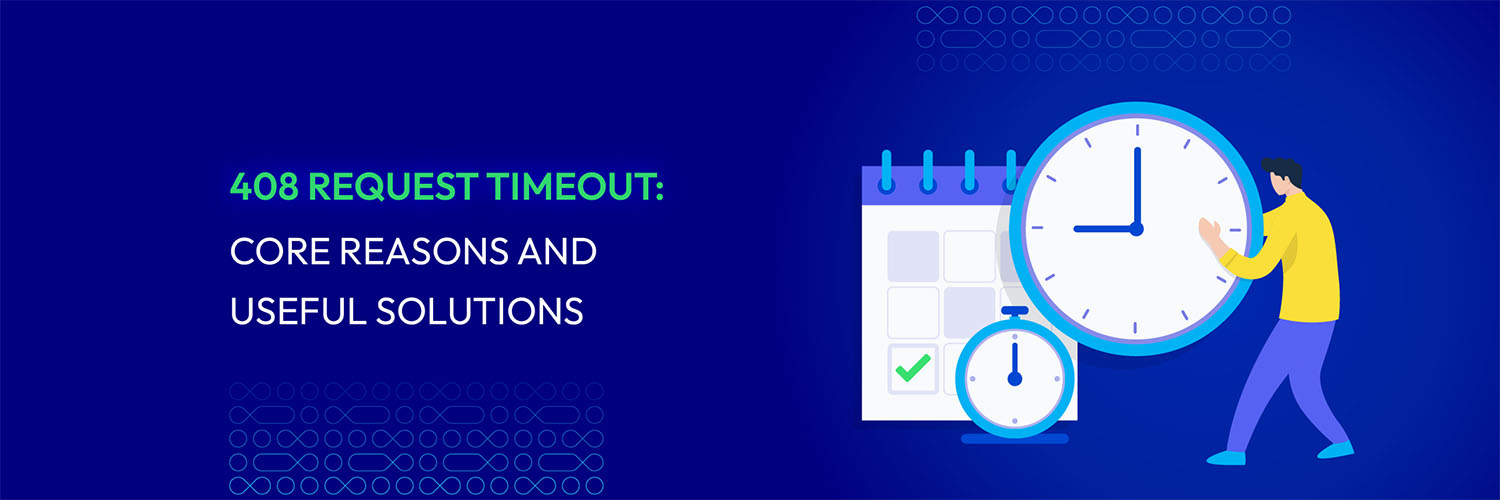8 Powerful Solutions to Resolve 408 Request Timeout Errors
Vinh Jacker | 07-28-2023

Delays or interruptions in web interactions can be annoying in the modern digital era, where the need for immediate access to information and smooth online experiences is crucial.
One instance is the “408 Request Timeout” error, a status code that denotes a breakdown in client-server communication. This error happens when the server doesn’t react within the anticipated time, leaving the client in suspense.
The significance of response timeouts and the core ideas of client-server communication will be covered first. Following that, we’ll look at the numerous things that can cause a 408 Request Timeout error. These variables include misconfigurations, application-level errors, server overload, and network-related issues.
While determining the underlying causes is essential, we will also arm you with workable ways to properly address the 408 Request Timeout problem. Both server-side and client-side fixes, such as improving network setups, modifying server settings, and putting best practices in web development into effect, will be covered.
What is the 408 Request Timeout error?
The HTTP 408 error, also known as HTTP status code 408 Request Timeout occurs when a server fails to respond to a client’s request within the expected time frame. This delay can stem from various factors such as network congestion, server overload, or issues with the client’s internet connection.

Essentially, the 408 Request Timeout signifies a breakdown in communication between the client and server. It’s the server’s way of informing the user that their request couldn’t be fulfilled within the specified time. This error can manifest when users access websites, interact with web applications, or make API calls, potentially disrupting their experience and productivity.
For developers, server administrators, and those managing web-based systems, understanding the causes and implementing effective solutions for the 408 Request Timeout error is crucial. By addressing underlying issues like network congestion or server overload, they can enhance the reliability and performance of web interactions, ensuring a smoother experience for users.
What are The Reasons For the “408 Request Timeout” Error?
Several factors, including the following, can cause the “408 Request Timeout” error:
-
Bandwidth and Connection Issues: Limited bandwidth, network congestion, or unstable internet connections can cause delays in transmitting client requests, leading to timeouts.
-
Inaccurate or Unavailable URLs: Typing incorrect URLs or accessing unavailable resources can confuse the server, resulting in wasted time and communication breakdowns, triggering the 408 error.
-
Web Server Configuration Errors: Incorrect server timeout settings or inadequate resource allocation can impact request processing, potentially leading to timeouts and the 408 error.
-
Application-Level Problems: Inefficient algorithms, slow database queries, or resource-intensive procedures in application code can prolong request processing times, contributing to timeouts and the 408 error.
-
Server Overload: Servers overwhelmed by excessive simultaneous requests may struggle to process them promptly, causing delays or timeouts and resulting in the 408 error.
Understanding these causes is essential for troubleshooting and implementing effective solutions to reduce the occurrence of the 408 error and ensure smoother client-server connections.
Free 1-1 consultation: Website Maintenance Service
Effects of Encountering the HTTP 408 Request Timeout Error
Encountering the HTTP 408 Request Timeout error can have varying effects depending on the context. Here are some potential outcomes:
-
User frustration due to interrupted browsing.
-
Decreased productivity for users relying on web-based tools.
-
Negative impact on business reputation and revenue.
-
Poor user experience leading to dissatisfaction.
-
Technical challenges for diagnosis and resolution.
-
Brand image deterioration from frequent errors.
-
Potential legal repercussions from data loss or financial impact.
-
Decreased SEO performance due to perceived website unreliability.
Overall, the HTTP 408 Request Timeout error can have far-reaching consequences, affecting user satisfaction, business outcomes, technical operations, and even legal considerations. It underscores the importance of proactive monitoring, optimization, and maintenance of web servers and applications to minimize its occurrence and mitigate its effects.
8 Solutions to Resolve the 408 Request Timeout Error
For Client-side
Here are some client-side suggestions for fixing the 408 Request Timeout error:
Verify the requested URL
It is essential to verify the requested URL’s accuracy. You should check the URL for typos, missing or inaccurate routes, and out-of-date pages. The server may have trouble processing the request if the URL is invalid or leads to an invalid resource, which will cause a timeout. You can eliminate this probable source of the 408 error by checking and fixing the URL.
Troubleshoot common platforms
If you encounter the 408 error while accessing a specific platform or website, it’s worth checking if there are any known issues or outages with that platform. Visit the platform’s status page or official support channels to see if they have reported any problems.
If the issue is on the platform’s end, you may need to wait for them to resolve it. Keeping an eye on official announcements or contacting their support team can provide valuable insights.
Reverse recent improvements
Your system’s most recent updates or changes may occasionally unintentionally generate conflicts or configuration problems that result in the 408 error. Consider going back and making the improvements you recently made, such as adjusting server settings, updating software, or changing the network setup. You can determine if the introduced alterations are the reason for the timeout problem by returning to the previous state.
Remove any new plugins, modules, or extensions
Conflicts that result in request timeouts might be brought on by plugins, modules, or extensions you have added to your web browser. Disable or temporarily uninstall any such additions you have just updated or installed. See how to remove unused CSS here.
This enables you to establish whether any of these extra components are the cause of the 408 error. After uninstalling them, if the error still doesn’t go away, you can either look for suitably updated versions or other ways to accomplish the functionality they offer.

Investigate potential database changes
If your application uses a database, modifications to the database’s structure or queries may affect how quickly requests are processed and cause timeouts. To enhance query performance, look over the queries being used, ensure they are optimized, and consider adding the right indexes.
Monitor database traffic as well, and look into any unexpected surges that might point to resource bottlenecks. The 408 error can be less frequent if database-related problems are found and fixed. See how to create a table using Magento Database Schema here.
Implementing these solutions can assist in troubleshooting and resolving client-side factors that contribute to the 408 Request Timeout error. However, it’s crucial to remember that the error’s root cause may also lie on the server side or involve network-related issues.
If the error persists after attempting these solutions, further investigation, collaboration with server administrators or developers, and network analysis may be required to identify and address the underlying cause effectively.
For Server-side
Here are some suggested fixes for the 408 Request Timeout issue on the server side:
Make sure your server is configured
Make sure your server is set up properly to handle incoming requests and provide a response within the anticipated time range. Examine the server’s configuration, paying attention to the resource allocations, connection limitations, and timeout values.
To improve server performance and account for the anticipated workload, make the necessary adjustments to these parameters. To learn about the configuration choices accessible to you, consult the documentation or support resources for the server software that you are using.
Examine the logs
Examine the server logs to learn more about the 408 error. Logs can shed light on the particular requests that are timed out and assist in spotting trends or typical causes of problems. Keep an eye out for any error messages, cautionary signs, or performance bottleneck clues.
Finding the fundamental cause and getting you on the right path to a solution can both be helped by analyzing the logs.

Debug the scripts or code in your applications
Check any custom scripts or code in your application to see if any potential bugs could hold up request processing. Search for inefficiencies, lengthy procedures, ill-optimized database queries, or other timeout-causing elements. To locate bottlenecks and modify the code accordingly, use performance profiling methods, log statements, or debugging tools.
Additionally, consider these general server-side optimization measures:
-
Optimize database queries: Poorly optimized queries can significantly impact server performance and response times. Ensure that database queries are properly indexed, and review the query execution plans to identify areas for improvement. Optimize the database schema and configuration to enhance query performance.
-
Implement caching: Utilize caching mechanisms to store and retrieve frequently accessed data, reducing the need for repeated processing. Caching can help improve response times and alleviate the load on the server.
-
Scale server resources: Evaluate the server’s resources, such as CPU, memory, and network bandwidth. If the server is consistently under heavy load, consider upgrading hardware or employing load-balancing techniques to distribute the workload across multiple servers.
-
Monitor and analyze performance: Implement monitoring tools to track server performance metrics such as CPU usage, memory utilization, and request response times. Continuously monitor these metrics to identify abnormal patterns or spikes that may indicate performance issues. Use performance analysis tools to diagnose and resolve bottlenecks.
By following these server-side solutions and optimization strategies, you can address potential causes of the 408 Request Timeout error and improve your server’s overall performance and reliability.
Conclusion
In conclusion, the 408 Request Timeout error can occur due to various factors on both the client and server sides. Understanding the underlying reasons behind this error is essential to effectively troubleshoot and resolve it. By understanding the causes and implementing the appropriate solutions, you can minimize the occurrence of the 408 Request Timeout error, resulting in improved user experience and seamless communication between clients and servers.
Remember to continuously monitor and adapt your system to changing requirements and emerging challenges to ensure optimal performance and reliable request handling. With a proactive approach, you can effectively resolve the 408 error and provide your users a smooth and efficient browsing experience.







